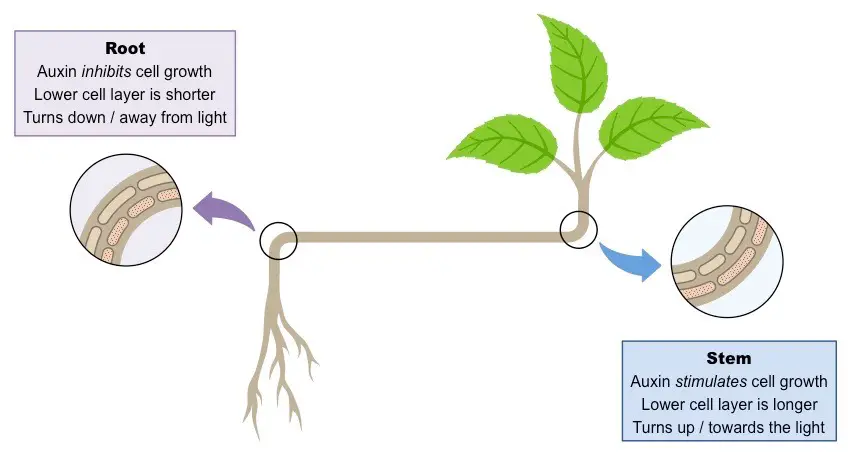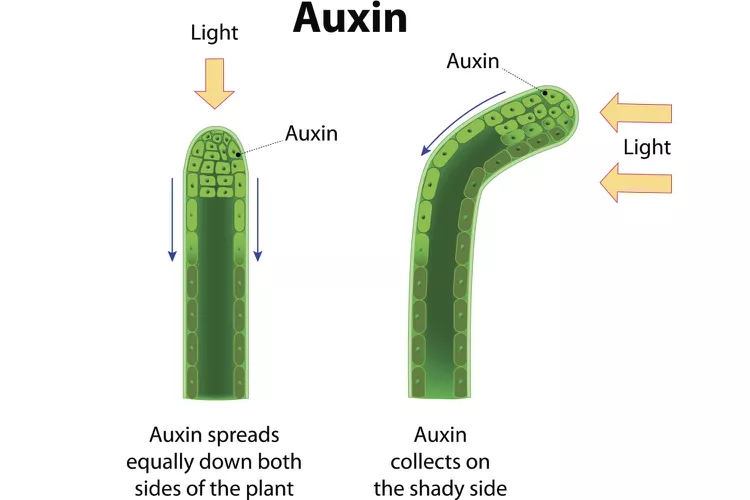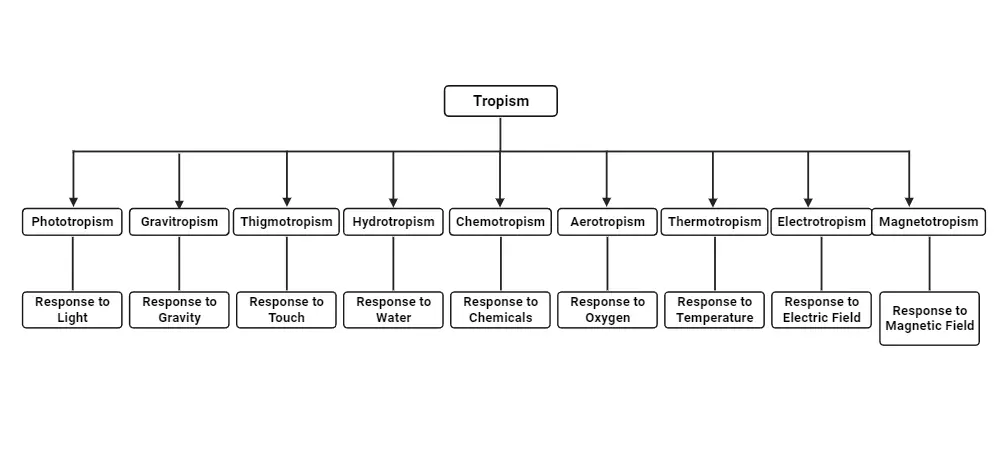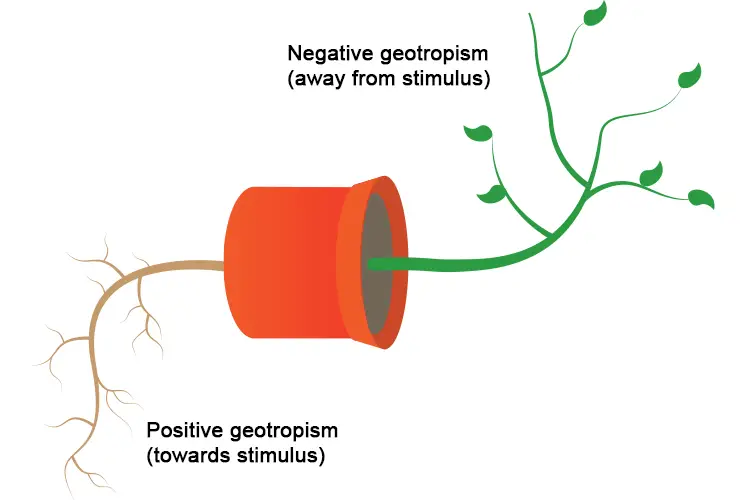Table of Contents
What is Tropism?
Tropism refers to the inherent capability of an organism, predominantly plants, to orient or move in reaction to an external stimulus. This response is not learned but is an innate, genetically encoded behavior. The nature of the response is contingent upon the direction of the stimulus, distinguishing it from nastic movements, which are non-directional.
The term “tropism” is derived from the Ancient Greek word τρόπος (trópos), signifying a turn or manner. In the realm of biology, it describes the growth or turning movement of an organism, especially plants, towards or away from an external stimulus. The naming convention for tropisms is typically based on the stimulus that triggers the movement. For instance, phototropism is a response to light, while gravitropism pertains to the organism’s reaction to gravity.
The process of tropism can be delineated into three successive stages:
- Sensation to the stimulus.
- Signal transduction.
- Directional growth response.
While tropisms are predominantly observed in plants, the phenomenon is not exclusive to them. Organisms capable of deliberate physical movement, or motility, in response to a specific stimulus are more aptly categorized under taxis (a directional response) or kinesis (a non-directional response).
One of the seminal models that shed light on tropism in plants is the Cholodny–Went model, introduced in 1927. This model elucidates tropism in emerging shoots of monocotyledons, highlighting the inclination of the stalk to gravitate towards light (phototropism) and the roots’ propensity to grow in the direction of gravitational pull (gravitropism). The model attributes this directional growth to the uneven distribution of auxin, a pivotal plant growth hormone.
In a broader context, the term “tropism” also finds relevance in virology, where it denotes “host tropism”, “tissue tropism”, or “cell tropism”. This refers to the evolutionary adaptation of certain viruses or pathogens to selectively target specific host species, tissues, or cell types within those species. Furthermore, in colloquial English, “tropism” might be employed to describe an action executed without conscious thought, symbolizing an inherent inclination or tendency to respond in a particular manner to a given stimulus.
In summation, tropism is a fundamental biological concept that underscores the innate responses of organisms, especially plants, to environmental stimuli. It is a testament to the intricate interplay between organisms and their environment, governed by genetic predispositions and evolutionary adaptations.

Definition of Tropism
Tropism is the innate response of an organism, particularly plants, to orient or move towards or away from an external stimulus, such as light or gravity.

Types of Tropism in Plants

Tropism, a fundamental biological concept, refers to the directed movement or orientation of an organism in response to an external stimulus. The nature of this response can vary based on the direction of the stimulus, and it can be categorized into various types based on the specific stimulus involved. Here, we delve into the primary types of tropism, elucidating their characteristics and providing pertinent examples.
- Phototropism: This refers to the movement or growth of an organism in response to light. For instance, plant stems and leaves exhibit positive phototropism as they grow towards the light source, while roots demonstrate negative phototropism, growing away from it.
- Gravitropism (Geotropism): Gravitropism is the orientation or movement of an organism in relation to gravity. In plants, stems exhibit negative gravitropism, growing against the gravitational pull, while roots display positive gravitropism, growing towards the center of gravity.
- Chemotropism: This type of tropism is characterized by the movement or growth of an organism in response to specific chemicals. Examples include the transformation of a flower into fruit or the movement of tentacles in the Drosera plant.
- Thigmotropism (Haptotropism): Thigmotropism pertains to the growth or movement of an organism in response to touch or physical contact. This is prominently observed in plant tendrils and twiners that coil around a support.
- Hydrotropism: In this tropism, the organism’s movement or growth is directed by the presence of water. Typically, plant roots exhibit positive hydrotropism, growing towards water sources.
- Thermotropism: This refers to the tropic movement of an organism in response to temperature variations. An exemplar of this is the Rhododendron plant, which reacts to atmospheric temperature changes.
- Magnetotropism: Certain organisms, especially some animals, exhibit movement or orientation in response to magnetic fields. This magnetic attraction often serves as a navigational guide, directing them towards specific poles.

In essence, tropisms are innate responses that enable organisms, predominantly plants, to adapt and thrive in their environment. These responses, governed by genetic and evolutionary factors, underscore the intricate relationship between organisms and their external stimuli, facilitating their survival and growth.
Types of Tropism in Virus
In the realm of virology, tropism delineates the specificity of a virus to infect particular cells, tissues, or species. This specificity is governed by the interaction between the virus and the host’s cellular receptors, determining the virus’s ability to attach, enter, and replicate within the host cell. Here, we explore the various types of tropism exhibited by viruses, elucidating their characteristics and providing pertinent examples.
- Amphotropic Tropism: Viruses exhibiting amphotropic tropism possess a wide host range, enabling them to infect multiple species or a variety of cell types. Such viruses are versatile and can adapt to diverse cellular environments.
- Ecotropic Tropism: In contrast to amphotropic viruses, ecotropic viruses have a restricted host range. They demonstrate specificity towards a single species or a particular cell type within that species. Their narrow host selection makes them highly specialized for their target cells.
- HIV Tropism: This refers to the mechanism by which specific strains of the Human Immunodeficiency Virus (HIV) gain entry into host cells. The tropism of HIV is determined by the co-receptor utilized by the virus to enter the cell, which in turn influences the progression of the disease and its response to certain antiretroviral therapies.
- Neurotropism: Viruses that exhibit neurotropism have a predilection for the host’s nervous system. They specifically target and infect neural tissues, leading to neurological manifestations in the infected host. Such viruses have evolved mechanisms to bypass the protective barriers of the nervous system, enabling them to cause infections like encephalitis or meningitis.
In summation, viral tropism is a pivotal factor in determining the pathogenesis, clinical manifestations, and epidemiology of viral infections. Understanding the specific tropism of a virus aids in predicting its potential hosts, transmission routes, and the clinical outcomes of the infection, thereby guiding therapeutic and preventive strategies.
Mechanism of Tropism
The mechanism of tropism involves a series of complex cellular and molecular processes that allow organisms, especially plants, to perceive and respond to environmental stimuli. Here’s a general overview of the mechanism of tropism:
- Perception of the Stimulus:
- The first step in any tropic response is the detection of the stimulus. Specialized cells or cellular structures, often located in specific regions of the plant (e.g., root or shoot tips), act as sensors.
- Signal Transduction:
- Once the stimulus is perceived, a signal transduction pathway is activated. This involves a series of cellular events where the initial stimulus is converted into a biochemical signal. This often involves secondary messengers, protein kinases, and other signaling molecules.
- Role of Plant Hormones:
- Auxins, a class of plant hormones, play a pivotal role in mediating tropic responses. In response to a stimulus, auxins are often redistributed within the plant tissue.
- For instance, in phototropism, light causes auxins to move to the shaded side of the plant, promoting cell elongation on that side and causing the plant to bend towards the light.
- Cellular Responses:
- The differential distribution of hormones, especially auxins, leads to varied cellular responses. This can include differential cell elongation, cell division, or changes in cell turgor pressure.
- In gravitropism, for example, cells on the lower side of a horizontally placed root will elongate less than those on the upper side, causing the root to bend downwards.
- Role of Ion Channels:
- Changes in ion concentrations, especially calcium ions, can play a role in the tropic response. The activation or deactivation of specific ion channels can lead to changes in cell turgor and cell elongation.
- Gene Expression and Protein Synthesis:
- Tropic responses can lead to changes in gene expression patterns. Certain genes might be upregulated or downregulated in response to a stimulus, leading to the synthesis of specific proteins that drive the tropic response.
- Feedback Mechanisms:
- Many tropic responses have built-in feedback mechanisms. Once the organism has adequately responded to the stimulus, mechanisms are in place to halt or reduce the response, preventing overreaction.
- Memory and Adaptation:
- Some plants exhibit a form of “memory” where prior exposures to a stimulus influence future responses. This can lead to adaptive responses where the plant becomes more efficient in responding to recurring stimuli.
- Integration with Other Processes:
- Tropic responses are often integrated with other physiological and developmental processes in the plant. For instance, the phototropic response might be modulated by the plant’s circadian rhythm.
In summary, the mechanism of tropism is a finely tuned process that ensures plants can adapt and respond to their ever-changing environment. It involves a combination of cellular, molecular, and physiological processes that are intricately coordinated to produce a directional growth response.
Factors Influence Tropism
Tropism in organisms, particularly plants, is influenced by a range of internal and external factors. These factors determine the direction, magnitude, and nature of the response. Here are the primary factors that influence tropism:
- Type of Stimulus: The nature of the stimulus is the primary determinant of the type of tropism. For instance, light induces phototropism, gravity induces gravitropism, and touch induces thigmotropism.
- Intensity of Stimulus: The strength or intensity of the stimulus can influence the degree of response. For example, a stronger light source might induce a more pronounced phototropic response.
- Duration of Exposure: The length of time an organism is exposed to a stimulus can affect the tropic response. Prolonged exposure might intensify the response or, in some cases, lead to adaptation where the response diminishes.
- Hormonal Regulation: Plant hormones, especially auxins, play a crucial role in mediating tropic responses. The differential distribution of auxins on the side of the plant exposed to the stimulus versus the unexposed side often drives the bending or growth response.
- Genetic Factors: The genetic makeup of an organism can influence its sensitivity and response to specific stimuli. Some plants might be genetically predisposed to exhibit stronger or weaker tropic responses.
- Age of the Organism: Younger plants or specific growth stages might be more responsive to certain stimuli. For instance, germinating seeds might exhibit a stronger gravitropic response compared to mature plants.
- Cellular and Molecular Mechanisms: The presence of specific receptors, signaling pathways, and cellular structures can influence how an organism perceives and responds to a stimulus.
- Environmental Conditions: External factors such as temperature, humidity, and soil conditions can modulate tropic responses. For instance, moisture gradients in the soil can influence hydrotropism.
- Previous Experiences: In some cases, prior exposure to a stimulus can influence future responses. For example, plants that have been previously exposed to light from one direction might exhibit a quicker phototropic response when exposed again.
- Interactions with Other Organisms: The presence of other organisms, such as symbiotic fungi or bacteria, can influence tropic responses. For instance, certain fungi release chemicals that can affect root growth direction.
- Internal Nutrient Levels: The internal nutrient status of the plant can influence its growth response. For example, a nitrogen-deficient plant might exhibit a stronger chemotropic response towards a source of nitrogen.
- Mechanical Barriers: Physical obstructions can influence tropic responses, especially in thigmotropism. For instance, a climbing plant might change its growth direction upon encountering a solid support.

In essence, tropism is a multifaceted response influenced by a combination of internal and external factors. Understanding these factors provides insights into the adaptive mechanisms that organisms employ to navigate their environment.
Different Stimuli for Tropism
Tropism refers to the growth or movement of an organism, especially plants, in response to specific external stimuli. Different types of tropisms are named based on the nature of the stimulus that induces the response. Here are the primary stimuli for tropism:
- Light:
- Stimulus: Sunlight or artificial light.
- Tropism: Phototropism. For instance, plant stems typically grow towards the light source (positive phototropism), while roots may grow away from it (negative phototropism).
- Gravity:
- Stimulus: Earth’s gravitational pull.
- Tropism: Gravitropism (or Geotropism). Roots generally grow downwards in the direction of gravitational pull (positive gravitropism), while shoots grow upwards, away from the ground (negative gravitropism).
- Touch or Physical Contact:
- Stimulus: Physical touch, such as a plant coming into contact with a solid object.
- Tropism: Thigmotropism. Climbing plants, for example, wrap around supports due to this response.
- Water:
- Stimulus: Moisture or water gradient in the soil.
- Tropism: Hydrotropism. Plant roots grow towards areas of higher moisture (positive hydrotropism).
- Chemicals:
- Stimulus: Specific chemicals or nutrients in the environment.
- Tropism: Chemotropism. For instance, pollen tubes grow towards the ovules in response to certain chemicals, and roots might grow towards certain nutrients.
- Oxygen:
- Stimulus: Concentration of oxygen.
- Tropism: Aerotropism. Some plant roots might grow towards areas with higher oxygen concentrations, especially in waterlogged soils.
- Temperature:
- Stimulus: Changes in environmental temperature.
- Tropism: Thermotropism. Some plants might alter their growth or orientation based on temperature gradients.
- Electric Field:
- Stimulus: Presence of an electric field.
- Tropism: Electrotropism (or Galvanotropism). Though less common, some studies suggest plants can respond to electric fields.
- Magnetic Field:
- Stimulus: Earth’s magnetic field or artificial magnetic sources.
- Tropism: Magnetotropism. Certain organisms might show growth or movement responses to magnetic fields.
- Wounding or Injury:
- Stimulus: Physical injury or damage.
- Tropism: Traumatotropism. Some plants might alter their growth direction after suffering an injury.
These stimuli play crucial roles in the survival and adaptation of plants to their environment. By responding to these external cues, plants can optimize their growth, reproduction, and overall health.
Importance of Tropism
Tropism plays a pivotal role in the survival, growth, and development of organisms, particularly plants. Understanding its importance provides insights into the adaptive mechanisms that organisms have evolved over time to respond to their environment. Here are some key points highlighting the significance of tropism:
- Optimal Resource Utilization: Tropisms ensure that plants grow towards or away from specific stimuli, allowing them to optimally utilize available resources. For instance, phototropism ensures that plants grow towards light, maximizing their ability to perform photosynthesis.
- Enhanced Survival: Tropisms increase the chances of survival for plants. For example, hydrotropism ensures that roots grow towards water sources, ensuring adequate hydration, especially in arid conditions.
- Stability and Anchorage: Geotropism or gravitropism ensures that roots grow downwards into the soil, providing stability and anchorage to the plant. This downward growth also allows roots to access deeper water sources during droughts.
- Reproductive Success: Some tropisms play a role in the reproductive success of plants. For instance, the growth of pollen tubes towards ovules in response to chemical gradients (chemotropism) ensures fertilization.
- Protection Against Adverse Conditions: Thigmotropism, or the response to touch, can protect plants from damage. For example, the rapid folding of the leaves of the Mimosa pudica when touched can deter herbivores or prevent damage from environmental factors.
- Efficient Nutrient Absorption: Roots can detect areas of the soil rich in specific nutrients and grow preferentially in those directions, ensuring efficient nutrient absorption.
- Adaptation to Environmental Changes: Tropisms allow plants to quickly adapt to changing environmental conditions. For instance, in response to changing light conditions, plants can alter their growth direction to maximize light absorption.
- Guided Growth: Tropisms provide a mechanism for guided growth without the need for cognitive decision-making. This innate response ensures that plants can consistently make beneficial growth decisions.
- Evolutionary Advantage: Over time, plants that exhibited beneficial tropisms had a competitive advantage over those that did not, leading to the evolution of these adaptive growth responses.
- Interactions with Other Organisms: Tropisms can also influence how plants interact with other organisms. For example, the growth of plant structures towards symbiotic organisms can enhance mutualistic relationships.
In summary, tropism is a fundamental biological phenomenon that ensures organisms, especially plants, can adapt and thrive in their environment. It underscores the intricate ways in which life has evolved to respond to external cues for survival and growth.
Examples of Tropism
- Fish Tropisms:
- Thigmotaxis: Fish typically exhibit negative thigmotaxis, wherein they move away from any tactile stimulus. This behavior aids them in evading predators and maintaining their position within a large school.
- Chemotropism: Fish have a pronounced sensitivity to various chemicals in their environment. A notable example is the release of specific chemicals by fish when they are under threat or upon death, signaling other fish to vacate the vicinity. Furthermore, salmon showcase a remarkable chemotropic response. They possess the ability to navigate vast oceanic distances and yet return to their natal streams for spawning. This behavior is attributed to the unique chemical signatures of the streams, which act as a beacon for the salmon, guiding their migration.
- Plant Tropisms in a Laboratory Setting:
- Geotropism: One of the earliest observations in botany was the geotropic response of plants. Regardless of the orientation of seed planting, roots invariably grow in the direction of gravitational pull, ensuring stability and access to nutrients.
- Hydrotropism: Roots inherently exhibit a tropic response to water, orienting themselves towards moisture-rich regions. This behavior, termed hydrotropism, is vital for the plant’s survival, ensuring consistent water uptake.
- Aerotropism: In conditions where water is deficient in oxygen, plant roots exhibit aerotropism. They actively seek oxygen, highlighting the plant’s adaptive response to fluctuating environmental conditions.
- Other Examples:
- Phototropism in Plants: Many plants exhibit phototropism, where they grow towards a light source. This is commonly observed in sunflowers, which turn their heads to follow the sun across the sky, ensuring maximum light absorption for photosynthesis.
- Heliotropism: Some plants, like the morning glory, exhibit heliotropism, where their flowers open in response to sunlight during the day and close during the night.
- Thermotropism: Certain plants display thermotropism, where their growth or movement is influenced by temperature. For instance, the petals of crocus flowers open when exposed to warmth and close in colder temperatures.
- Magnetotropism: Some bacteria, known as magnetotactic bacteria, exhibit magnetotropism. They contain magnetosomes, which are magnetic particles that align with the Earth’s magnetic field, aiding in their navigation.
- Rheotropism: Seen in aquatic plants, rheotropism is the growth or movement in response to the current of water. For instance, the roots of certain aquatic plants will orient themselves in the direction of water flow.
- Skototropism: This refers to the growth of organisms away from light. Certain fungi and molds exhibit skototropism, preferring dark, damp environments for growth.
- Halotropism: Some plants, especially those in saline environments, show halotropism, where their growth or movement is influenced by salt concentrations. For instance, the roots of halophytic plants may grow away from areas of high salt concentration.
- Nastic Movements: While not strictly tropisms (as they are non-directional), nastic movements in plants are worth mentioning. For example, the Mimosa pudica plant exhibits a rapid folding of its leaves when touched, a phenomenon known as thigmonasty.
In essence, tropisms are innate, evolutionarily conserved behaviors that enable organisms to adapt and respond to their ever-changing surroundings. These responses, whether in fish navigating vast oceans or plants seeking essential resources, underscore the intricate interplay between organisms and their environment, facilitating their survival and growth.
Quiz
Which type of tropism refers to the growth or movement of an organism in response to light?
a) Geotropism
b) Hydrotropism
c) Phototropism
d) Chemotropism
The growth of plant roots towards water is an example of:
a) Thermotropism
b) Hydrotropism
c) Aerotropism
d) Phototropism
Which tropism is exhibited by plants growing in the direction of gravitational pull?
a) Geotropism
b) Phototropism
c) Chemotropism
d) Aerotropism
The movement of sunflower heads to follow the sun is an example of:
a) Heliotropism
b) Skototropism
c) Rheotropism
d) Magnetotropism
Which type of tropism is exhibited by plants in response to touch or contact?
a) Thermotropism
b) Thigmotropism
c) Magnetotropism
d) Chemotropism
The growth of a plant in response to temperature changes is termed:
a) Phototropism
b) Hydrotropism
c) Thermotropism
d) Geotropism
Which tropism is exhibited by certain bacteria that align with the Earth’s magnetic field?
a) Geotropism
b) Phototropism
c) Magnetotropism
d) Aerotropism
The growth of plant roots away from areas of high salt concentration is an example of:
a) Halotropism
b) Phototropism
c) Thermotropism
d) Rheotropism
The rapid folding of the leaves of the Mimosa pudica plant when touched is an example of:
a) Thigmonasty
b) Skototropism
c) Rheotropism
d) Heliotropism
Which type of tropism refers to the growth or movement of an organism in response to chemicals?
a) Phototropism
b) Geotropism
c) Aerotropism
d) Chemotropism
FAQ
What is tropism?
Tropism refers to the growth or movement of an organism, typically a plant, in response to an external stimulus.
How many types of tropism are there?
There are several types of tropism, including phototropism, geotropism, chemotropism, thigmotropism, hydrotropism, thermotropism, and more.
What is phototropism?
Phototropism is the growth or movement of an organism in response to light. For example, plants growing towards a light source exhibit positive phototropism.
Why do roots grow downwards?
Roots exhibit geotropism or gravitropism, where they grow in the direction of gravitational pull. This ensures they anchor the plant and access nutrients from the soil.
What causes plants to respond to touch?
Thigmotropism is the growth or movement in response to touch or contact. Plants like the Mimosa pudica (touch-me-not) exhibit rapid leaf folding when touched due to this tropism.
Why do sunflowers turn towards the sun?
Sunflowers exhibit heliotropism, where they move or grow in response to the direction of the sun. This maximizes their exposure to sunlight, aiding in photosynthesis.
How do plants detect water sources?
Through hydrotropism, plant roots grow and move towards areas with higher moisture or water concentration, ensuring they access the water needed for survival.
What is the role of auxin in tropism?
Auxin is a plant hormone that plays a crucial role in various tropisms. It regulates cell elongation, allowing parts of the plant to grow towards or away from stimuli.
Can animals exhibit tropism?
While tropism is primarily associated with plants, certain animals, like fish, can also exhibit tropisms in response to various stimuli such as chemicals or touch.
Why is tropism important for plants?
Tropism ensures that plants grow and adapt in ways that maximize their chances of survival. For instance, growing towards light ensures efficient photosynthesis, while growing roots towards water ensures adequate hydration.
References
- Biology Dictionary. (n.d.). Tropism. Biology Dictionary. https://biologydictionary.net/tropism/
- Vedantu. (n.d.). Tropism. Vedantu. https://www.vedantu.com/biology/tropism
- Biology Online. (Last updated date). Tropism. Biology Online. https://www.biologyonline.com/dictionary/tropism
- ThoughtCo. (n.d.). Plant Tropisms. ThoughtCo. https://www.thoughtco.com/plant-tropisms-4159843
- Atamian, Hagop S., et al. “Circadian regulation of sunflower heliotropism, floral orientation, and pollinator visits.” Science, American Association for the Advancement of Science, 5 Aug. 2016, science.sciencemag.org/content/353/6299/587.full.
- Dietrich, Daniela, et al. “Root hydrotropism is controlled via a cortex-specific growth mechanism.” Nature Plants, vol. 3 (2017): 17057. Nature.com. Web. 27 Feb. 2018.
- Chen, Rujin, et al. “Gravitropism in Higher Plants.” Plant Physiology, vol. 120 (2), 1999, pp. 343-350., doi:10.1104/pp.120.2.343.
- Stowe-Evans, Emily L., et al. “NPH4, a Conditional Modulator of Auxin-Dependent Differential Growth Responses in Arabidopsis.” Plant Physiology, vol. 118 (4), 1998, pp. 1265-1275., doi:10.1104/pp.118.4.1265.
- Takahashi, Nobuyuki, et al. “Hydrotropism Interacts with Gravitropism by Degrading Amyloplasts in Seedling Roots of Arabidopsis and Radish.” Plant Physiology, vol. 132 (2), 2003, pp. 805-810., doi:10.1104/pp.018853.
- Esmon, C. Alex, et al. “Plant tropisms: providing the power of movement to a sessile organism.” International Journal of Developmental Biology, vol. 49, 2005, pp. 665–674., doi:10.1387/ijdb.052028ce.


